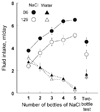Mouse taste preference tests: why only two bottles?
- PMID: 12771018
- PMCID: PMC2613179
- DOI: 10.1093/chemse/28.4.315
Mouse taste preference tests: why only two bottles?
Abstract
Two-bottle tests have been used extensively to measure the preference for taste and nutrient solutions but there has been little work with tests involving more than two bottles. Here, we compare the results obtained in two-bottle tests with those obtained in three- and six-bottle tests. In Experiment 1, we measured the preferences for 2 mM saccharin, 50 mM citric acid, 0.3 mM quinine hydrochloride and 75 mM NaCl displayed by 129X1/SvJ (129) and C57BL/6J (B6) mice. Mice drank more taste solution when they received two bottles providing taste solution and one providing water than when they received either a standard two-bottle test or two bottles providing water and one providing taste solution. The three-bottle tests also revealed the left spout side preferences of the 129 strain and were generally better at distinguishing between the 129 and B6 strains (i.e. were more sensitive) than were the two-bottle tests. In Experiment 2, we measured intakes and preferences in tests with six bottles, with one, two, three, four or five containing 75 mM NaCl and the rest containing water. NaCl preferences were monotonically related to the number of NaCl spouts available. A follow-up experiment found similar results whether the index of ingestion was volume intakes or licks. This argues that spillage cannot account for the effect of spout number on taste solution intake. Together, the results suggest that (i) the number of bottles of taste solution and water has a profound influence on taste solution intake and preference, and (ii) three-bottle tests may be more sensitive than two-bottle tests in many circumstances.
Figures



Similar articles
-
Taste solution preferences of C57BL/6J and 129X1/SvJ mice: influence of age, sex, and diet.Chem Senses. 2007 Sep;32(7):655-71. doi: 10.1093/chemse/bjm034. Epub 2007 Jun 12. Chem Senses. 2007. PMID: 17566070 Free PMC article.
-
The maintenance diets of C57BL/6J and 129X1/SvJ mice influence their taste solution preferences: implications for large-scale phenotyping projects.J Nutr. 2002 Aug;132(8):2288-97. doi: 10.1093/jn/132.8.2288. J Nutr. 2002. PMID: 12163677 Free PMC article.
-
Influence of test duration on the sensitivity of the two-bottle choice test.Chem Senses. 2002 Nov;27(9):759-68. doi: 10.1093/chemse/27.9.759. Chem Senses. 2002. PMID: 12438201
-
Chorda tympani responses in two inbred strains of mice with different taste preferences.Physiol Behav. 1999 Aug;67(2):287-97. doi: 10.1016/s0031-9384(99)00071-2. Physiol Behav. 1999. PMID: 10477061 Review.
-
Strain differences in sucrose- and fructose-conditioned flavor preferences in mice.Physiol Behav. 2012 Jan 18;105(2):451-9. doi: 10.1016/j.physbeh.2011.09.010. Epub 2011 Sep 14. Physiol Behav. 2012. PMID: 21945373 Free PMC article.
Cited by
-
Genetic mutation of Tas2r104/Tas2r105/Tas2r114 cluster leads to a loss of taste perception to denatonium benzoate and cucurbitacin B.Animal Model Exp Med. 2024 Jun;7(3):324-336. doi: 10.1002/ame2.12357. Epub 2023 Dec 28. Animal Model Exp Med. 2024. PMID: 38155461 Free PMC article.
-
Influence of the number of alcohol and water bottles on murine alcohol intake.Alcohol Clin Exp Res. 2003 Apr;27(4):600-6. doi: 10.1097/01.ALC.0000060529.30157.38. Alcohol Clin Exp Res. 2003. PMID: 12711922 Free PMC article.
-
Ethanol Conditioned Taste Aversion in High Drinking in the Dark Mice.Brain Sci. 2019 Jan 1;9(1):2. doi: 10.3390/brainsci9010002. Brain Sci. 2019. PMID: 30609665 Free PMC article.
-
Taste solution preferences of C57BL/6J and 129X1/SvJ mice: influence of age, sex, and diet.Chem Senses. 2007 Sep;32(7):655-71. doi: 10.1093/chemse/bjm034. Epub 2007 Jun 12. Chem Senses. 2007. PMID: 17566070 Free PMC article.
-
Manipulating beaver (Castor canadensis) feeding responses to invasive tamarisk (Tamarix spp.).J Chem Ecol. 2008 Aug;34(8):1050-6. doi: 10.1007/s10886-008-9496-1. Epub 2008 Jun 27. J Chem Ecol. 2008. PMID: 18581180 Clinical Trial.
References
-
- Batsell WR, Best MR. One bottle too many? Method of testing determines the detection of overshadowing and retention of taste aversions. Anim. Learn. Behav. 1993;21:154–158.
Publication types
MeSH terms
Substances
Grants and funding
LinkOut - more resources
Full Text Sources
Other Literature Sources

